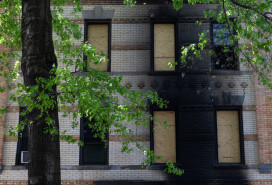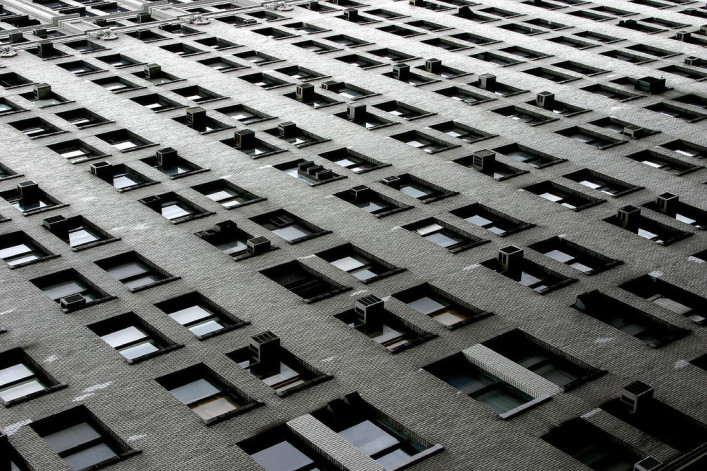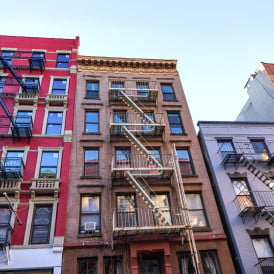Ask Sam: How do I find out if my apartment should be rent-stabilized—and if the landlord owes me money?
I suspect my apartment is supposed to be rent-stabilized, but my landlord swears that it isn't. How do I find out if it's been illegally de-stabilized? How much does my landlord owe me if it has?
If you think your apartment was illegally de-stabilized, the first step is to do a little detective work, says Sam Himmelstein, a lawyer who represents residential and commercial tenants and tenant associations. "Whether you’re stabilized or not has nothing to do with what your landlord says or what your lease says," he explains.
To start your digging, he says, find out how many apartments are in the building (and how many there were when it was built), and if it's ever had a renovation. "Talk to your neighbors and learn about the history of the building," says Himmelstein. "Who lived in your place before, what they paid, were they stabilized. Try to ascertain if your apartment was renovated and if so, when, what work was done, and how much it might have cost."
You should also request your apartment's registration history from the Division of Housing and Community Renewal to find out how much past tenants have been charged, and how much the rent has been raised (tips on putting in a request to the DHCR can be found here).
But you may need to go beyond the DHCR: "What we find a lot, especially in gentrifying Brooklyn where landlords are terrified of being told their buildings are stabilized, is that they will file fake registrations and the DHCR doesn't really scrutinize it," Himmelstein says. "They'll say an apartment was occupied by the owner or an employee, or invent fictitious tenants." Talk to your neighbors, he advises, or see if you can track down past tenants to find out if they were really paying the rent your landlord claimed they were.
"We've seen a real uptick in the past few years in cases involving rent stabilization status," he says. Depending on the nature of your building, there are several common scenarios you'll want to look into to ensure you are not being illegally overcharged:
1. The rent was illegally raised out of stabilization. As a rule, any rental building with six or more units that was built before 1974 is rent-stabilized, provided that it's not a co-op, condo, or government-subsidized or government-owned building. However, rent-stabilized apartments can eventually become deregulated. Historically, the way this happened was that the apartment became vacant with a legal rent over the applicable threshold of $2,000, $2,500 or $2,700, (depending on when the vacancy occurred) for more a month. It was widely assumed by the landlord-tenant community that rent could be increased through vacancy increases, renewal increases, major capital improvements (made throughout the building) authorized by the DHCR, and individual apartment improvements, and if the new rent exceeded the threshold, the apartment was deregulated.
However, some recent changes in the law now require that the rent of the outgoing tenant be above the applicable threshold in order for the next tenant to be de-regulated. (For a full list of circumstances that can lead to deregulation, the Rent Guidelines Board has a guide.) Look at the rent history to see how much the rent has been raised per year, and how much the landlord has upped the rent in between tenants. (When a new tenant comes in, landlords can charge a "vacancy increase" of around 20 percent.) Analyze the registration history to see what kind of rent hikes or upgrades the landlord would have had to make to get to a point where the apartment was deregulated, says Himmelstein. If there was work done—and it was used to justify a rent hike—bring in a contractor to give an estimate of its value so you can cross-check what your landlord claimed to have put into it. "Very often the landlord didn’t do those improvements, or claimed that they did something worth more than they actually did," says Himmelstein.
2. The building has a J-51 tax abatement. As long as a landlord is still receiving a J-51 tax abatement for major renovations to the building, its rental apartments should remain rent-stabilized. To check on the status of your building, look up its block and lot number by plugging your address into the HPD website, then put that information into the city's J-51 Benefit History Request screener. If the building currently receives a J-51 tax abatement (or you moved in before the abatement expired), you're entitled to stabilized rent, and can likely get damages from the landlord (more on that later).
3. The building has a 421a tax abatement. These are the tax abatements given to new construction projects in exchange for including rent-stabilized apartments, so would likely only apply if you live in a newer building. To find out if your building has a 421a, you'll have to sift through the city's PDF database of properties that currently have the abatement, and see if your address turns up. It's hard to challenge the rents in these buildings—they're usually set by landlords at the outset and approved by HPD—unless your landlord has been raising your rent at rates higher than those set by the Rent Guidelines Board (currently, that's one percent per year).
4. The building has a 421g tax abatement. This abatement was established in 1995 in order to revitalize lower Manhattan, by providing landlords with tax abatements, energy rebates, and other financial incentives to convert commercial buildings to residential ones, explains attorney Serge Joseph. These landlords, in turn, were required to treat the apartments in their buildings as subject to rent stabilization laws.
To determine whether you're in such an apartment, Joseph advises that you look up your building's tax bill. "If the owner is currently receiving benefits, there should be a line that talks about the basis for it that mentions 421g or 'lower Manhattan conversion,'" he says. "You definitely want to check not only the current tax bill, but also go back a couple years. You'll want to see whether the building was in receipt of these benefits."
The tax breaks were put in place for 12 to 14 years, but many downtown buildings began receiving benefits in the 2000s and should still be stabilized. Moreover, in a building where the tax benefit has expired, apartments could still be stabilized if the landlord didn’t legally raise their rent to above the applicable threshold.
Plus, Himmelstein points out, with all the tax abatement programs, landlords can only deregulate apartments upon the end of the abatement if they put a rider in the original and all renewal leases advising tenants that their tenancy was subject to rent-stabilization because of tax benefits, and let them know about its pending expiration. "But it's rare to see these riders, which means that if you're in one of these apartments, you may remain stabilized until you leave, even after the tax abatement expires. That's potentially a very valuable thing," Himmelstein says.
5. The building is subject to a regulatory agreement. Some landlords have been provided with benefits in the form of tax abatements or mortgage subsidies, on the condition of a regulatory agreement with the city or state to provide tenants with stabilized status. You can find out if this applies to your building by searching for its deed on ACRIS. "This is just emerging as a possible new basis to claim rent stabilization," Himmelstein says.
6. The landlord is running a preferential rent scam. If your landlord tells you that they're charging you a lower or "preferential" rent than the supposed legal regulated rent, you'll want to do some research, as the landlord may be attempting to build a false rental history, and the original, "legal" rent really wasn't. (And even when it's above-board, preferential rent can mean your landlord hiking your rent way up upon lease renewal; read more about this practice here.) William Gribben, partner at HMGDJ Law, suggests you take a close look at your apartment's original and renewal leases to see if your landlord included a rider allowing him or her to take away the preferential rent, and to see if there were any especially high rent increases over the years.
7. The landlord is illegally renting out rooms individually in a regulated apartment. Some landlords--again, particularly in gentrifying Brooklyn--will rent individual rooms to separate tenants, charging a total rent that is higher than what they could get under rent stabilization laws. Moreover, despite being told they're only renting one room in the apartment, each tenant is still liable for all the rent should their roommates move out. "If someone leaves and the others left begin to pay only their share, the landlord is short the money and they go after the people that are left to come up with the entire rent," Gribben says. Know that renting rooms individually is illegal in NYC, so if you encounter a landlord doing this, it should raise some major red flags.
8. The building is bigger than it appears to be. Remember the standard rule: if a building was built before 1974 and has six or more apartments, it should likely be stabilized. So if you're in a smaller building with fewer than six units, find out if that number has decreased over the years—if, say, your building has five apartments but the landlord used to rent out the basement, your building should likely be rent-stabilized. There's also something called the "horizontal multiple dwellings" rule: if two small, neighboring buildings (with a total of six or more apartments between the two of them) are managed or financed as a single entity—and share common elements like a walkway, boiler, or sewer line—they should be rent-stabilized. "We see these all the time," says Himmelstein, who adds, "But a landlord can't get out of rent-stabilization by reducing the number of apartments."
So if, after your sleuthing, it looks like you should be living in the land of the rent-stabilized, what do you do?
FIRST STEPS: As with most landlord disputes, the first thing to do is write the landlord to make them aware of the problem, and ask for documents tracing the history of Major Capital Improvements (i.e., upgrades to the building) or Individual Apartment Improvements, both of which could be used to prove or disprove what your landlord is charging you for rent. If you're forgoing a lawyer, rather than withholding rent and going to court (which is likely to land you on the tenant blacklist), you can use those documents to file a rent overcharge complaint with the DHCR (the forms for which can be found here).
THE GOLDEN RULE: One big thing to keep in mind when planning your approach: something called the "four-year rule," which dictates that the landlord generally is not required to prove how and why the rent was increased more than four years before the date you make a formal claim; however, the four-year rule doesn’t apply when the issue is whether or not the apartment is stabilized. Also, there is a four-year statute of limitations, which states that the landlord will only have to reimburse you for overcharges dating from four years before you made a formal claim. If you decide to work with an attorney, you should contact the landlord requesting documentation so that your rightful rent can be determined.
NEGOTIATING TACTICS: You have two options. The first is to withhold rent, and when you get taken to court for non-payment, defend yourself on the grounds that you're a rent-stabilized tenant and you have been overcharged. The second option is to sue the landlord, which means your case would get taken to the state Supreme Court. This has the added advantage of something called "pre-trial discovery," which means that your lawyer would be entitled to all the relevant documentation about your building before the case even goes to trial. "If enough tenants in the same building or complex are in a similar situation, they may be able to join forces to file a multi-party lawsuit or a class action," says Himmelstein.
THE NUMBERS GAME: The tricky part in all this is determining what your rightful rent should be, and therefore, how much money you're owed. The standard rule of thumb is to set the rent at the amount charged and paid four years prior to the date the formal claim was made, plus any lawful increases. However, if the rent was the product of a fraudulent scheme to remove the apartment from rent stabilization, the rent may be substantially reduced by setting it at the amount of the lowest legal rent of a comparable apartment (same number of rooms) in the building, rolling the rent back by 20 percent, or lowering the rent to the amount paid by the previous tenant – whichever amount is lowest. After deciding the amount overcharged, the tenant is awarded triple damages (three times the amount overpaid) on the latest two years of over-payments, unless the landlord can prove that the overcharge was not willful. On any amount of overcharge that triple damages do not apply to, the tenant is awarded interest at the rate of nine percent per year, as well as attorneys’ fees. “The interest really adds up,” says Himmelstein.
THE PAY DAY: So how much do you stand to gain if your apartment's been illegally deregulated, and you've been overpaying? Himmelstein cites a client in an Upper East Side building with a J51 tax abatement whose landlord not only rolled back the rent from $4,400 to $2,700 a month, but refunded the tenant $96,000 in overcharges and interest. In a case where the landlord couldn't prove that $25,000 worth of renovations had been done to an apartment, another client with his firm had their rent rolled back from $2,500 a month to $1,875, and received $75,000 for overcharges.
In addition, the firm is currently litigating several class actions and numerous individual and multi-plaintiff cases, in which the aggregate overcharge recovery, through settlements and court rulings, will end up being in the millions of dollars, with large reductions in the monthly rent and recovery of attorney’s fees.
[This article was originally published in December 2014, and was updated in September 2017.]
Related:
Attention NYC renters: thanks to a new ruling, your apartment might be rent-stabilized after all (sponsored)
Ask Sam: I found out my apartment used to be rent-stabilized. Now what? (sponsored)
Ask Sam: My landlord's renovation is making my life miserable. What are my rights? (sponsored)
See all Ask a Renters' Rights Lawyer
Sam Himmelstein, Esq. represents NYC tenants and tenant associations in disputes over evictions, rent increases, rental conversions, rent stabilization law, lease buyouts, and many other issues. He is a partner at Himmelstein, McConnell, Gribben, Donoghue & Joseph in Manhattan. To submit a question for this column, click here. To ask about a legal consultation, email Sam or call (212) 349-3000.



























